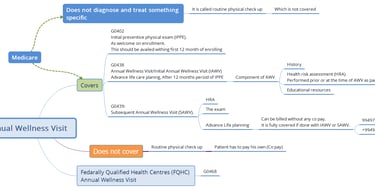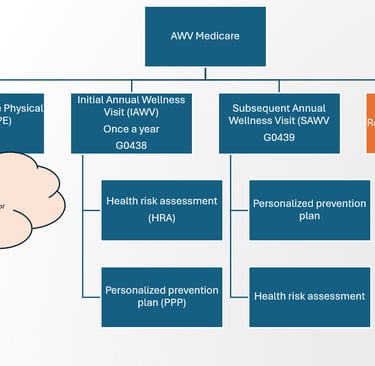Annual wellness visit
Preventive medicine services cater to individuals who do not require immediate medical attention but benefit from regular health checkups to prevent potential health issues.
Synonyms:
- Preventive Care Visit
- Wellness Exam
- Preventive Medicine Visit
- Annual Health Checkup
- Yearly Physical


Difference between Wellness visit and sick visit: -
Preventive Visit:
A preventive visit, also known as a well visit or annual physical exam, is a proactive approach to healthcare. It involves a comprehensive check-up with a healthcare provider when you are not sick but rather to maintain your overall health and detect any potential health issues early. These visits are crucial for preventing illnesses and promoting overall well-being.
During a preventive visit, your healthcare provider will typically conduct a thorough physical examination, including checking your vital signs such as blood pressure, heart rate, and temperature. They may also perform screenings for various conditions, such as cholesterol levels, blood glucose levels, and cancer risks based on your age, gender, and family history.
Immunization reviews are often part of preventive visits, ensuring that you are up to date with recommended vaccines. Your healthcare provider may also discuss lifestyle modifications, such as diet, exercise, and smoking cessation, to help you maintain or improve your health.
One of the key benefits of preventive visits is that they are usually covered by insurance plans at no cost to the patient. This means that you can receive essential healthcare services without worrying about financial barriers.
Sick Visit (Office Visit):
A sick visit, also known as an office visit or acute care visit, is scheduled when you have specific health issues, symptoms, or concerns that require medical attention. These visits are focused on addressing acute or chronic conditions, managing illnesses or injuries, and providing treatment options to help you recover.
During a sick visit, your healthcare provider will assess your symptoms, perform necessary examinations, and may order tests or lab work to diagnose your condition accurately. Based on the diagnosis, they will prescribe medications, recommend treatments, or refer you to specialists if needed.
Sick visits may involve insurance copays and additional costs depending on the services provided. Unlike preventive visits, which are proactive, sick visits are reactive and aim to address immediate health concerns to help you feel better and recover from illness or injury.
In summary, preventive visits focus on maintaining health and detecting potential issues early, while sick visits address specific health issues, symptoms, or concerns requiring medical attention. Both types of visits play a crucial role in maintaining overall health and well-being.
The following services are available under preventive medicine:
• Blood pressure, diabetes and cholesterol tests
• Cancer screenings
• Counselling for depression
• Annual health check-up
• Routine vaccinations against diseases such as measles or meningitis
• Counselling, screening and vaccines for healthy pregnancies
• Flu shots
• Mammogram
• Colonoscopy
Coding guidelines for non-Medicare patients
These services are based on the age on the patient.
Coding guidelines for Medicare patients
1. Initial Preventive Physical Examination (IPPE): G0402
Description: The Initial Preventive Physical Examination (IPPE), also known as the "Welcome to Medicare Preventive Visit," is a face-to-face visit for new Medicare beneficiaries during the first 12 months of Medicare enrollment (Part B).
Key Points:
Once-in-a-lifetime benefit.
Does not include Advanced Care Planning (ACP).
If patient visits after 12 months of enrollment, the Initial Annual Wellness Visit (IAWV) (G0438) is billed.
Copayment and coinsurance waived, deductible waived.
Note: If the patient availed G0402 upon enrollment and returns for routine physical examination the next year without receiving Health Risk Assessment (HRA) & Personalized Prevention Plan (PPP), it's not covered by Medicare, and a copay is required.
Initial Annual Wellness Visit (IAWV): G0438
Description: The Initial Annual Wellness Visit (IAWV) includes a personalized prevention plan of service (PPS), initial visit.
Key Points:
Can use HRA from the previous year for the current HRA and update as needed.
Includes Advanced Care Planning (ACP).
Optional: cognitive exam.
Can be billed after 12 months of IPPE (G0402) or after the eligibility of IPPE has finished.
Subsequent Annual Wellness Visit (SAWV): G0439
Description: The Subsequent Annual Wellness Visit (SAWV) includes a personalized prevention plan of service (PPS), subsequent visit.
Key Points:
Done year after year after IAWV.
ACP is included in IAWV in SAWV.
Optional: cognitive exam.
What is HRA and what are the components?
Health Risk Assessment (HRA) is a systematic approach to identifying health risks and conditions in individuals. The HRA is designed to gather comprehensive information about an individual's health status, lifestyle, and risk factors, which can then be used to develop personalized health recommendations and interventions.
The components of a Health Risk Assessment (HRA) can vary depending on the specific tool or questionnaire used, but typically include the following categories:
Demographic Information: This includes basic information such as age, gender, and race/ethnicity.
Medical History: Questions about past medical conditions, surgeries, hospitalizations, and current medications.
Family History: Information about the health conditions of family members, especially close relatives such as parents and siblings.
Lifestyle Factors: Questions about diet, exercise, smoking, alcohol use, drug use, and other health-related behaviors.
Mental Health: Questions about stress, anxiety, depression, and other mental health concerns.
Physical Activity: Information about the frequency, intensity, and type of physical activity.
Nutrition: Questions about dietary habits, including intake of fruits, vegetables, and other food groups.
Safety: Questions about home and workplace safety, as well as use of seat belts and protective equipment.
Environmental Exposures: Questions about exposure to environmental toxins, pollutants, and other hazards.
Healthcare Utilization: Information about past healthcare visits, screenings, and immunizations.
Health Goals: Patient's goals and priorities related to health and well-being.
A personalized prevention plan is tailored to an individual's health needs and goals. Here's an example of what it might include:
1. Health Goals: Identify specific health goals such as weight loss, smoking cessation, or managing chronic conditions like diabetes or hypertension.
2. Nutrition Plan: Provide dietary recommendations based on individual needs, such as a balanced diet rich in fruits, vegetables, whole grains, and lean proteins. Include guidance on portion control and reducing intake of unhealthy fats, sugars, and sodium.
3. Physical Activity: Recommend an exercise regimen tailored to the individual's fitness level and health goals. This may include aerobic activities like walking, jogging, or swimming, as well as strength training exercises.
4. Smoking Cessation: Offer support and resources for quitting smoking, including counseling, nicotine replacement therapy, or medication if needed.
5. Screening Schedule: Provide a personalized schedule for recommended screenings and immunizations based on age, gender, and risk factors. This may include screenings for cancer, heart disease, diabetes, and vaccinations such as flu shots and pneumonia vaccines.
6. Mental Health: Address mental health and stress management, including strategies for coping with anxiety, depression, or other mental health issues. Referrals to mental health professionals may be included if necessary.
7. Medication Management: Review current medications and provide education on proper use, potential side effects, and interactions. Discuss strategies for medication adherence.
8. Fall Prevention: Assess fall risk and provide recommendations for reducing hazards in the home, improving balance and strength, and using assistive devices if needed.
9. Follow-Up Plan: Schedule regular follow-up visits to monitor progress, adjust the plan as needed, and provide ongoing support and motivation.
10. Other Recommendations: Include any other personalized recommendations based on individual health status, family history, and lifestyle factors.
The personalized prevention plan is designed to empower individuals to take an active role in their health and well-being, with the goal of preventing illness, promoting healthy behaviors, and improving overall quality of life.


